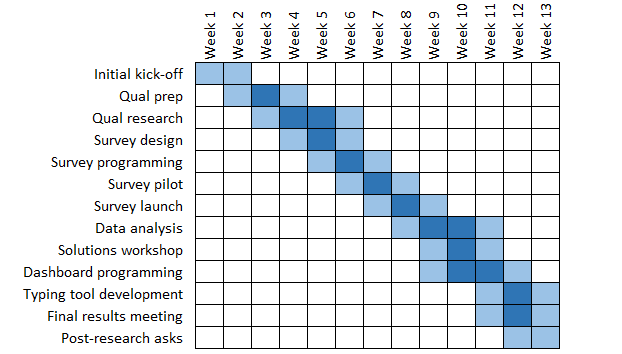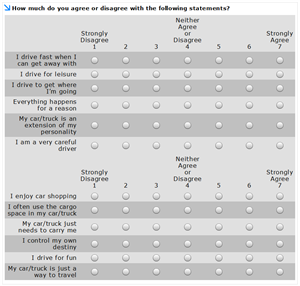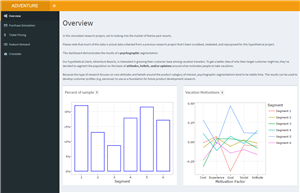Are you early in the development process, or interested in having a deeper understanding of your end users? Segmentation is front-end product development research that helps identify customer subgroups in the market that have similar characteristics. Target segments can be identified and studied further, with the end goal of discovering new product concepts and/or features that these subgroups will highly value.
How it works
I typically recommend psychographic segmentation, that is, using attitudes, beliefs and/or opinions as a basis for developing user segments. Attitudinal beliefs and opinions tend to be stable over time, giving the research a longer shelf life.
I work with clients to develop 15-25 attitudinal questions that uncover the different personality types with respect to the product category in question. Based on answers to these questions, I segment the population into 5-9 subgroups, minimizing the differences in attitudes of users within each subgroup, and maximizing the differences in attitudes between subgroups.
Once potential segmentation solutions have been identified, I hold a workshop with project stakeholders to review potential solutions. The winning solution should meet three additional criteria; 1) there should be differences in potential value to the company between segments, 2) different segments should be identifiable, typically through demographic differences, and 3) the size of target segments should be large enough to warrant investing in further product development to meet the unique needs of users within those segments.
With the winning segmentation solution identified by stakeholders during the segmentation review workshop, I develop a typing tool to categorize users. This consists of a subset of 5-7 items from the original 15-25 items used as a basis for segmentation. Additionally, I can work with your designers to develop empirically based user personas representing each segment.
Pros:
-
The result of a comprehensive segmentation research project is an in depth understanding of how different subgroups of users feel about your product category. Valuable subgroups can be targeted for follow-up research using a 5-7 item typing tool. Most importantly, segmentation provides an empirically based overview of the different types of users out there, and helps provide a conceptual framework to move forward and develop products/features with specific user segments in mind.
-
Segmentation research is most powerful when combined with follow-up research. For example, when running pricing studies, it’s possible to confirm that target segments do indeed value new features more than a baseline population of users. When moving forward towards production, representatives of target segments can be identified for usability studies.
Cons:
-
The segmentation research I specialize in is forward looking. While it’s OK and in some cases recommended to include current customers as survey respondents, I typically recommend learning about potential customers with the strategic goal in mind of increasing the overall customer base for clients.
-
Segmentation research is very time intensive. Since segmentation research serves to create a strategic foundation for future product development, stakeholders should include at a minimum designers and product managers. Because these results potentially speak to an entire product line or portfolio, general manager input is also welcome.
-
The following represents a cautious segmentation research timeline. Please note that this process is designed to accommodate client schedules and incorporates 2-3 iterations per milestone to incorporate feedback from all stakeholders.


